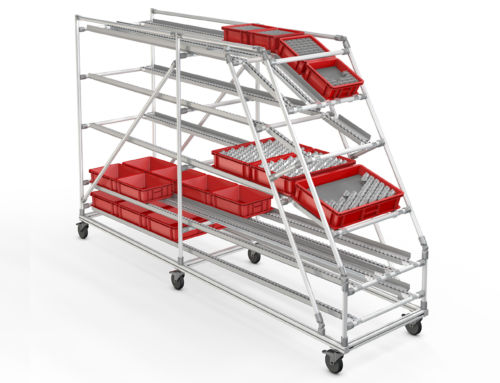Es hora de echar un vistazo al Chaku-Chaku, otro método lean inspirador.
“Chaku” translates as “load” or “insert”. Using the same word twice – “Chaku-Chaku” – offers a clue that this particular lean production method is based on comparatively simple working processes. All that workers have to do is load a machine, or position a workpiece in it, and move workpieces from one machine to another. The actual processing work and ejection steps are completed in a largely or entirely automated process. All the workstations needed to manufacture a product are located as closely to each other as possible to avoid long distances. This results in lines being arranged in a U or Ω shape, as is the case in the one-piece flow method. The worksteps and workstations are arranged in a strict sequence and, often, each member of staff will be able to operate every station. One crucial advantage to the Chaku-Chaku principle is that it introduces flexibility to the system’s output, which means per-person productivity remains consistently high, even if the number of staff is increased. After all, the focus is on ensuring the people – rather than the stations and machines – are working to their full capacity. In other words, the machines wait for the people and not the other way around.
Hanedashi, Jidoka and Karakuri/LCA help with Chaku-Chaku
As explained above, when work is organized using the Chaku-Chaku method, the actual processing of the work piece happens largely on an automated basis. Frequently, a machine will also eject the processed part itself, too. This is often because suitable ejection devices can be added to a machine relatively cheaply. By contrast, incorporating a device that could load work pieces into a machine with precision would be a very expensive affair. This is why Chaku-Chaku works well in combination with the Hanedashi method. In this method, which equates to automatic unloading, the operator places the work piece into the machine by hand, with the machine processing it and subsequently ejecting it. The operator can then pick up the workzpiece and either take it to the next workstation or pass it on to the next operator on the line. While the processed workpiece is being passed on, the machine readies itself for processing the next workzpiece. As a result, operators can complete their work without any distractions and the ergonomics of the assembly workstation are enhanced, since staff can avoid the unergonomic movements associated with unloading tasks.
When it comes to ejection processes, Karakuri/LCA (Low Cost Automation) – i.e. automation systems that don’t use drives, sensors, electricity or compressed air – can be very useful. For instance, Profile Tube System D30 can be used to create automated applications that rely solely on the laws of gravity and mechanics. If staff following the Chaku-Chaku method are operating several machines in parallel, it is pretty much impossible for them to maintain an overview of everything at the same time. However, lean production has a tried-and-tested solution for this, too – Jidoka. If machines are fitted with monitoring systems that use sensors, for example, they can identify when something has gone wrong and shut themselves down automatically. This is why Jidoka is also referred to as autonomation – a combination of the words “automation” and “autonomy”.
Poka-Yoke and 5S help with Chaku-Chaku, too
Poka-Yoke, which translates as “the avoidance of unfortunate errors”, is another tool that helps operators run multiple machines smoothly under the Chaku-Chaku method. Poka-Yoke utilises mechanisms that either directly avoid mistakes (hard Poka-Yoke) or point out a potential error (soft Poka-Yoke). When using the Chaku-Chaku method, only hard Poka-Yoke is taken into account. For example, imagine a machine that will only start processing a part when that part has been inserted correctly and in a precise position. This means the operator can move straight on to the next machine in the Chaku-Chaku line and will only need to return to the previous one when the Hanedashi mechanism has done its job.
However, Poka-Yoke is not just helpful when the rabbit chase principle is being followed, i.e. when every operator needs to have mastered every workstep. Poka-Yoke can also be combined with Chaku-Chaku when the sequence principle is being implemented. In this scenario, operators only take care of certain sequences in the Chaku-Chaku cell and therefore don’t need to take responsibility for every workstep. All the same, no matter which approach is taken, organisation and clarity are absolutely essential because the Chaku-Chaku method is based on processes that have become second nature and high speeds. 5S from the visual management toolbox is the ideal lean method for delivering these essentials:
- Sorting out and removing what isn’t needed right away.
- Setting everything out in an ergonomic arrangement and labelling working materials.
- Scrutinising and thoroughly cleaning the workplace.
- Standardising steps 1 to 3 to make them second nature.
- Sustaining your observance of the rules and continuously improving the workplace and processes.
Are you interested in fascinating reports and innovations from the world of lean production?
Then we have just what you’re looking for! Simply subscribe to the item blog by completing the box at the top right.
.









